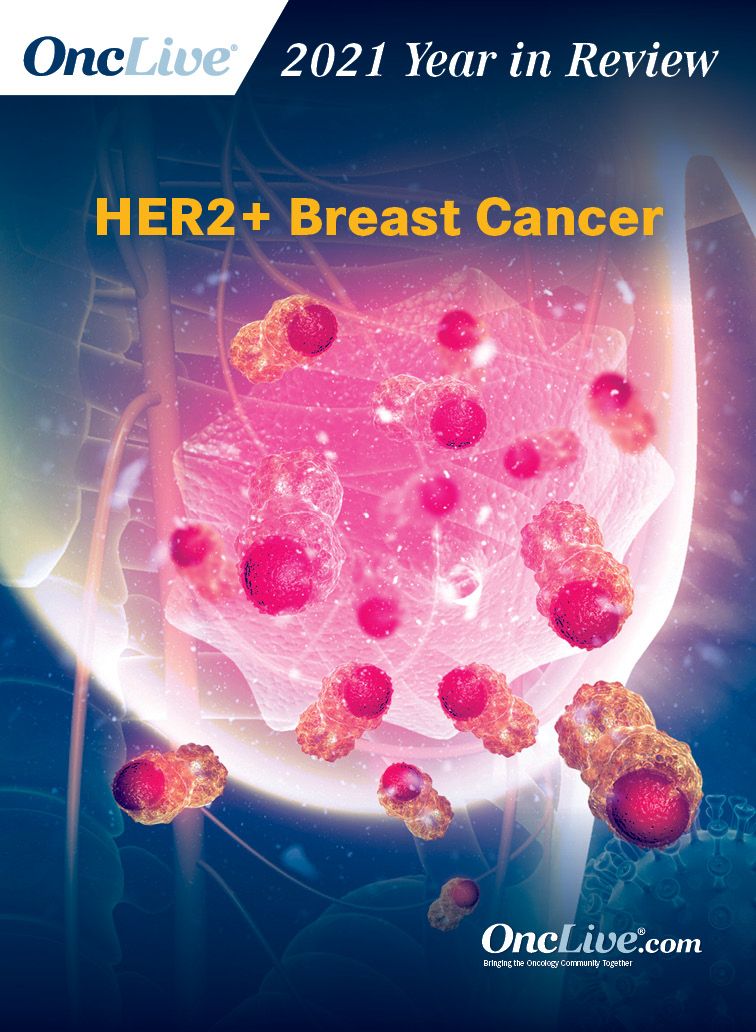Publication
Article
Sequencing Strategies Shift in Metastatic HER2+ Breast Cancer
Author(s):
Ruta D. Rao, MD, discusses factors that inform treatment selection for patients with metastatic HER2-positive breast cancer, the effects key data that emerged in 2021 have had on sequencing, strategies to mitigate toxicities associated with trastuzumab deruxtecan, and remaining questions regarding sequencing that may be the focus of ongoing research effort.
Ruta D. Rao, MD

Although frontline standard of care of care for patients with metastatic HER2-positive breast cancer remains the combination of trastuzumab (Herceptin), pertuzumab (Perjeta), and a taxane, the second-line setting has recently undergone a paradigm shift with the incorporation of fam-trastuzumab deruxtecan-nxki (Enhertu) as a standard option, said Ruta D. Rao, MD. She added that sequencing will likely continue to evolve when data evaluating agents like trastuzumab deruxtecan and tucatinib (Tukysa) in earlier lines of therapy are reported.
“It’s nice to have a multitude of treatment options now for our patients,” Rao said. “We spend a lot of time [thinking about] what we are going to use in the second- and third-line settings. The first-line setting is pretty well established and, now, the second-line [setting] is between one of 2 choices: [trastuzumab deruxtecan or (ado)-trastuzumab deruxtecan (T-DM1; Kadcyla)]. It is also nice to know that we have very potent [and] active medications we can give in the third- and fourth-line settings also.”
In an interview with OncLive®, Rao discussed factors that inform treatment selection for patients with metastatic HER2-positive breast cancer; the effects on sequencing that key data that emerged in 2021 have had; strategies to mitigate toxicities associated with trastuzumab deruxtecan; and remaining questions regarding sequencing that may be the focus of ongoing research efforts. Rao is an associate professor in the Department of Internal Medicine of the Division of Hematology, Oncology, and Cell Therapy at Rush Medical College; director of the Coleman Foundation Comprehensive Breast Cancer Clinic; and medical director of the Rush University Cancer Center.
OncLive®: What factors influence your treatment recommendations for patients with HER2-positive breast cancer?
Rao: Certainly, the patient is the No. 1 [factor, which includes their] performance status, the extent and burden of their disease, and what line of therapy it is for them. We make different choices based on whether [the patient requires] first-line, second-line, or third-line treatment. Most importantly, [we take into consideration] what the patient’s wishes are. It’s important to explain to the patient that metastatic [HER2-positive] breast cancer is treatable but not curable. The treatment can often go on for years now because we have such good treatments, but [the patient] also has to [be willing to] accept the toxicities that come with the treatments.
The combination of trastuzumab, pertuzumab, and a taxane seem to be well established in the frontline setting for patients with metastatic HER2-positive breast cancer. After progression on that regimen, what available agents do you tend to reach for?
Typically, in the metastatic setting, the first-line treatment would be trastuzumab, pertuzumab, and a taxane. Prior to this past year, T-DM1 was our second-line choice. However, based on the head-to-head DESTINY-Breast03 [NCT03529110] data that we saw in the latter half of 2021, we now know that trastuzumab deruxtecan is a very good choice for second-line treatment [compared with T-DM1].
Could you elaborate on the results of the DESTINY-Breast03 trial in terms of efficacy and toxicity with trastuzumab deruxtecan?
[DESTINY-Breast03] is a phase 3 trial comparing T-DM1 with trastuzumab deruxtecan. The HR was 0.28, showing a very significant benefit for the patients who received trastuzumab deruxtecan in the second-line setting. This has moved [trastuzumab deruxtecan] to second-line treatment for a lot of our patients.
Whenever we decide to give a drug, we have to weigh the toxicities with it. From the first trial with trastuzumab deruxtecan, we saw interstitial lung disease [ILD] as one of the toxicities. In [DESTINY-Breast03], it was a little bit more reassuring to see that all cases of ILD were grade 1 or 2, [and ILD occurred in] about 10.5% [of all patients]. Whether that is because this was a less heavily pretreated population or because the investigators were more aware of ILD as an adverse effect [AE] to watch for carefully is hard to know.
[That all cases were grade 1 or 2] reassuring to us, but [ILD] is something that has to be taken into account and it makes [trastuzumab deruxtecan] not necessarily a treatment for everybody. If somebody comes in with significant underlying pulmonary comorbidities, [trastuzumab deruxtecan] may not be the drug of choice for them.
What measures are considered when a patient is started on trastuzumab deruxtecan to mitigate the risk of ILD or other AEs associated with that agent?
In terms of pulmonary toxicity, we end up doing more frequent CT scans to look for [ILD] because we would like to find it before it becomes symptomatic.
The other main toxicity I’ve seen with [trastuzumab deruxtecan] is nausea. With that, we have to be more aggressive with antinausea medications.
What other antibody-drug conjugates (ADCs) are you keeping an eye on and how do you anticipate the data will translate into clinical utility?
We saw some data presented recently on trastuzumab duocarmazine. We have seen, starting with T-DM1, that ADCs are a great way to deliver the drug to HER2-positive breast cancers. We have to start paying attention to what the [optimal] chemotherapy partner is and what the associated toxicities are.
We have seen with T-DM1 that [common toxicities] are mainly thrombocytopenia, some elevated liver function tests, and some neuropathy. With trastuzumab deruxtecan, ILD is an AE. With trastuzumab duocarmazine, [we saw] some ocular toxicity. I’m not sure how that will translate into clinical utility based on what the toxicity of that drug is. We need more data.
How did the field’s understanding of tucatinib’s role in metastatic disease change in 2021 with the update from the phase 2 HER2CLIMB trial (NCT02614794)?
Data from the HER2CLIMB trial [showed an] overall survival [(OS) benefit with tucatinib, capecitabine (Xeloda), and trastuzumab] for patients with brain metastases, either active or stable. It was interesting to see [the data] divided out that way.
In addition, it was interesting to see the trial looking at tucatinib in patients with leptomeningeal metastases. Although we have to keep in mind that that is a small trial, the [investigators] did show a median OS of 10 months compared with 4 to 5 months, which [compares favorably with] historical controls. That reveals that this subset of patients with leptomeningeal disease, which otherwise has a very poor prognosis, may be candidates for this treatment.
It was [also] nice to see, at the 2021 San Antonio Breast Cancer Symposium, some further analysis of drugs that we have gotten excited about over the past couple of years.
Regarding treatment sequencing, what questions were answered in 2021 and what unanswered questions may be the focus of research this year?
One question that was answered [regards optimal] second-line treatment. One question that remains unanswered is: How does one ADC work after another? I don’t know if we will be able to tell that from clinical trials; [we will] probably [learn] more from clinical experience. If we give a patient trastuzumab deruxtecan, would we give them T-DM1 in the third-line setting? [The answer is] probably yes, but what will be its efficacy?
Another answer we are now waiting to hear is: How do these drugs like trastuzumab deruxtecan and tucatinib do in the early-stage setting? A lot of ongoing trials are evaluating these agents in the setting of residual disease. In addition, tucatinib [is being evaluated] with T-DM1. It will be important to see how these agents fare in the early-stage setting. If something becomes a standard of care in the early-stage setting, that changes how often and in what line we would use that drug in the metastatic setting as well.
How have the updated National Comprehensive Cancer Network (NCCN) guidelines influenced your practice for patients with HER2-positive breast cancer?
In the updated NCCN guidelines, trastuzumab deruxtecan is now an option for second-line [treatment], [along with] T-DM1. However, they left trastuzumab deruxtecan as a preferred regimen, which is helpful for us because if we want to give it to patients, we have the justification to do so.
Trastuzumab, capecitabine, and tucatinib is listed in the third-line setting and beyond, as are other active HER2-directed drugs, such as neratinib [Nerlynx], margetuximab-cmkb [Margenza], and trastuzumab, plus different chemotherapy agents. It is nice to have different options to offer these patients.








